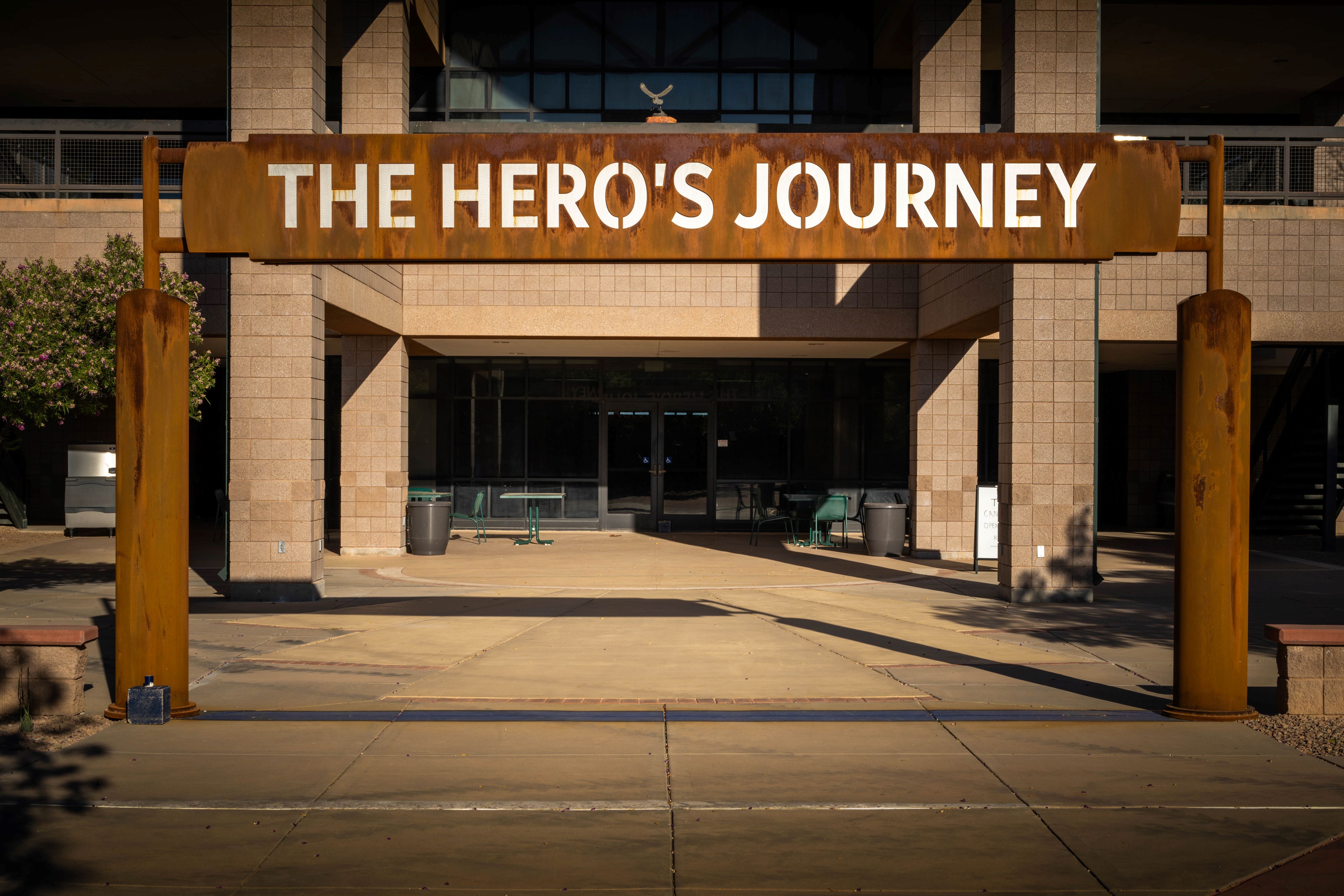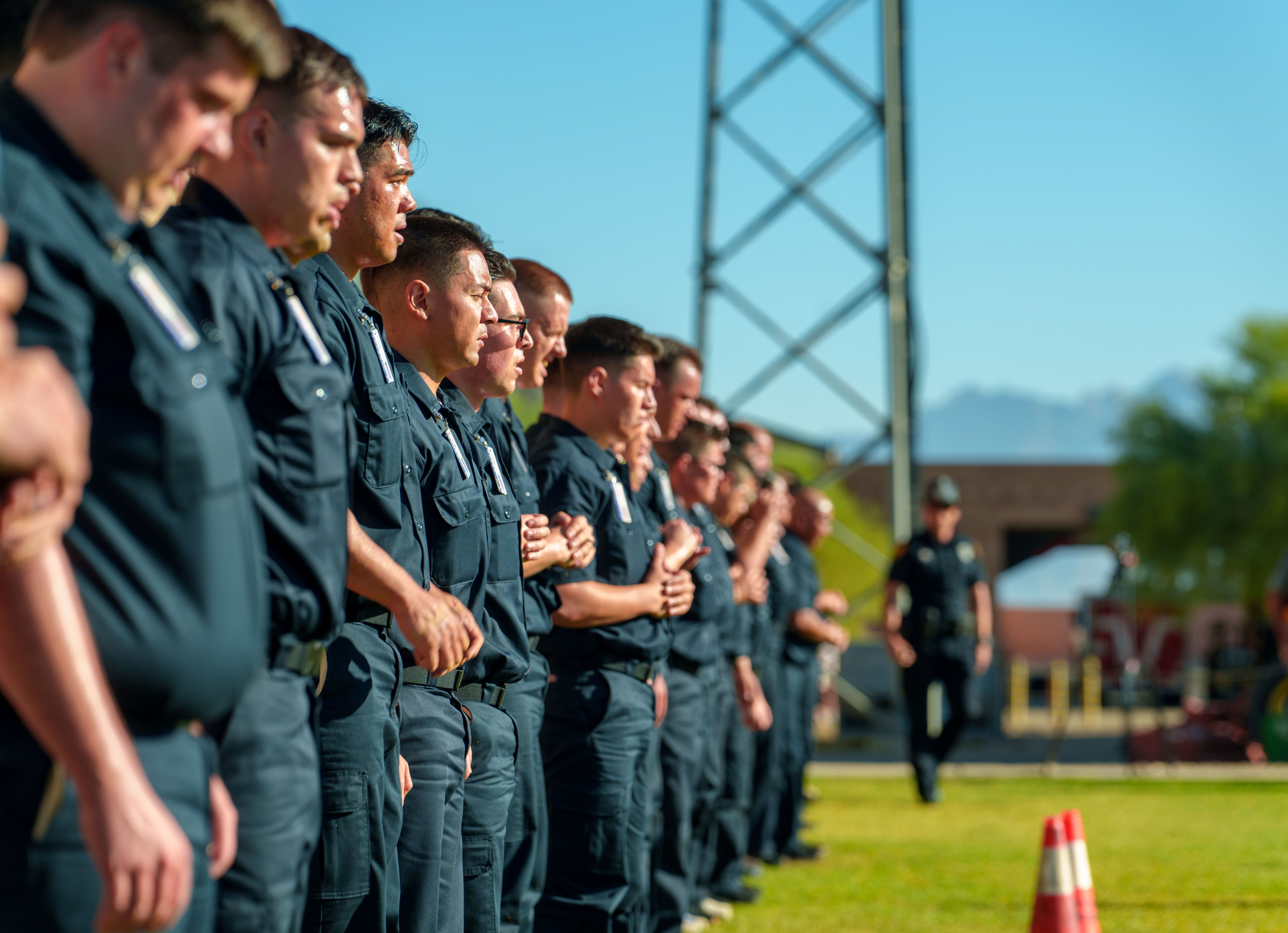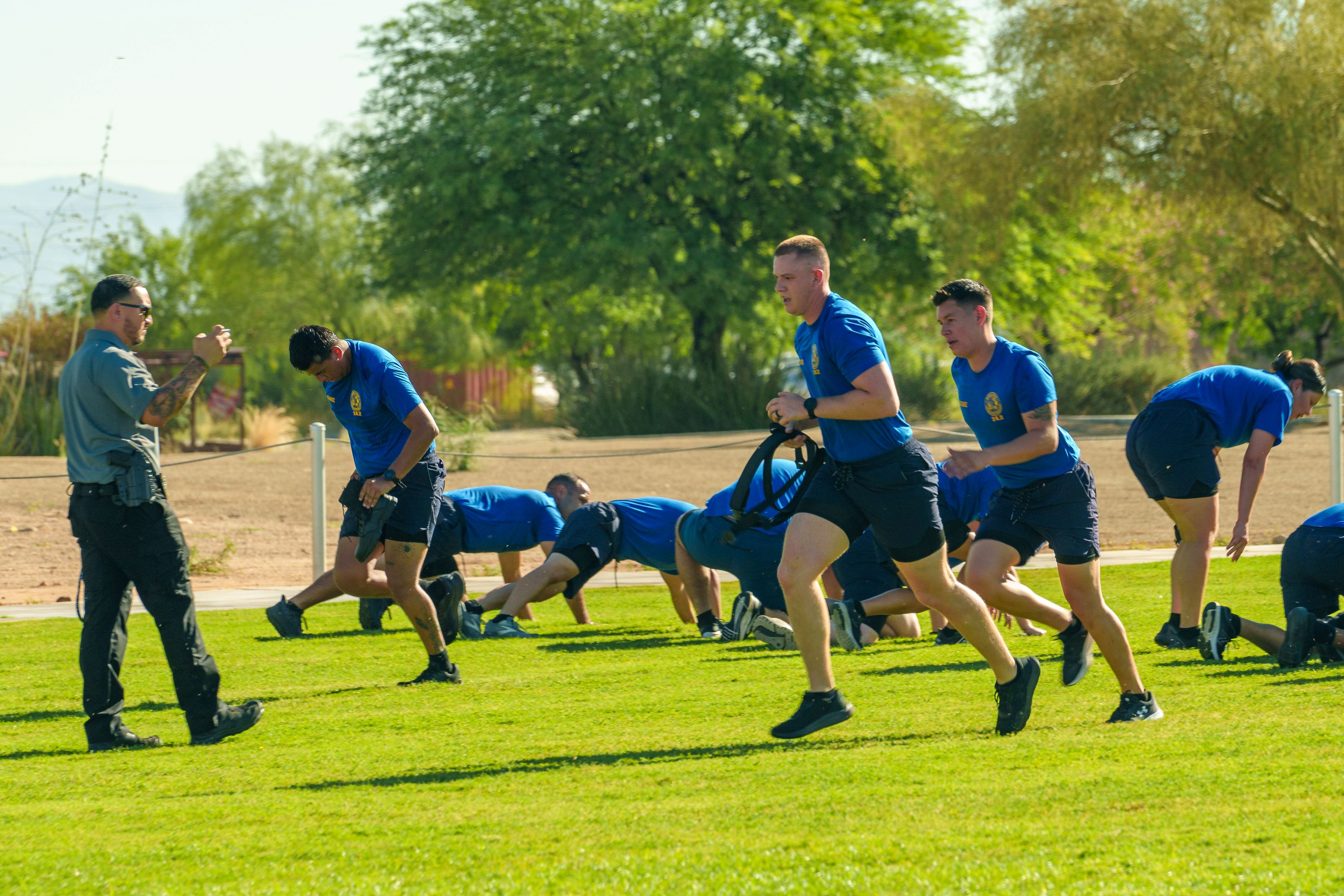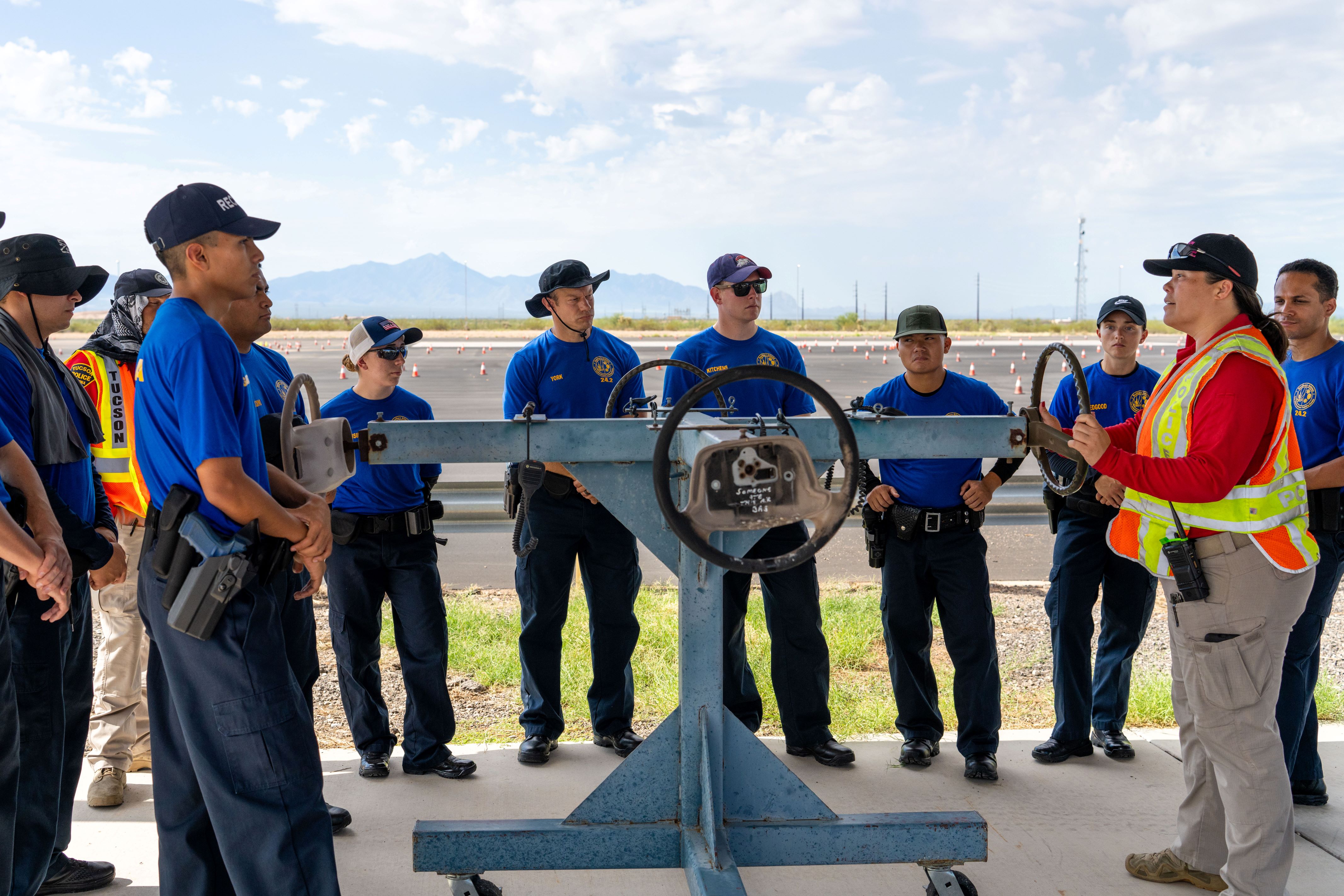Welcome to the Southern Arizona Law Enforcement Training Center.
Your journey begins here...The basic training program is a 30-week curriculum, designed to challenge students mentally, physically, and academically.
Each law enforcement agency participating with SALETC has a training coordinator to assist recruits with training questions. As well as, to help prospective recruit candidates prepare to meet the demands of the training, specific information about the program and our training standards follow.
The following links will take you directly to the listed topic on this page.
- Physical Fitness Preparation (pdf)
- General Exercise Pattern
- Cardiovascular Endurance
- Strength Training
- Flexibility
- Fitness Tests
- Cooper Physical Fitness Norms (pdf)
- Police Officer Physical Aptitude Test
- Applied Skills Proficiency
- Firearms Training & Qualifications
- Driver’s Training
- Report Writing
- Defensive Tactics Training
Arriving at the Academy
Recruit officers are expected to be punctual when reporting for duty at the academy. Those selected to attend will be notified of the time and place to report. Recruits should come prepared to participate in both classroom and physical activity.
Vehicles & Parking
Recruits must have a valid drivers license and are required to park in the south parking lot. If parking is not available in this lot, parking in the north lot is permissible. The academy is located in close proximity to three prisons, therefore, all vehicles will be locked up. Recruit vehicles shall display current Arizona motor vehicle registration tags.
Attire
In the first week, recruit officers are required to wear appropriate business attire. For men this consists of a button down shirt, necktie, dress pants and dress shoes or cross trainers. For women, a blouse, dress slacks, flat dress shoes or cross trainers. Recruit officers will begin wearing agency uniforms at the discretion of the class supervisor and need to have their agency uniform available no later than the beginning of week two.
Required uniform articles:
- Agency short- or long-sleeve shirt as designated by the class supervisor
- Agency pants
- Agency belt
- Agency authorized uniform shoe or boot
- Crew neck T-shirt with no markings (color authorized by individual agencies)
- Gun/Utility belt (when directed)
- Brassiere (females)
- Agency approved socks
Recruit officers are required to purchase their physical training uniforms from an authorized vendor for the first day of training. The physical conditioning program involves strength and aerobic exercises. It is highly recommended that you have a good pair of running or cross-training shoes to prevent injury.
Physical Training Uniform:
- Blue T-shirt
- Blue shorts
- Solid white mid-calf or over-the-calf athletic socks
- Athletic shoes
- Mouthpiece
- Brassiere (females)
- Athletic supporter and athletic cup (males—when required)
- Navy blue BDU pants, (available at Pima Uniforms)
Grooming
Recruit officers shall maintain the highest standards of personal hygiene.
- Hair may be worn in contemporary styles, but no longer than the top of the shirt collar at the back of the neck, and no lower than the top of the ear at the sides when the recruit is in a standing position with the head in normal posture.
- Hair shall at all times be neatly trimmed, clean and combed.
- Multicolored hairstyles, ponytails, and braids are prohibited.
- Females shall arrange their hair to conform to these standards if they choose to have long hair.
- Sideburns will not extend below the mid-ear.
- Mustaches shall not extend below the corner of the mouth or hang below the upper lip.
- Beards are prohibited.
- Earrings, bracelets (other than medical ID), necklaces, chokers, brooches, or other items of jewelry that constitute a safety hazard are prohibited.
Meals
Recruit officers are required to bring their own lunch. A refrigerator and microwave are available in the lunchroom. Recruit officers are not permitted to leave the campus for meal purposes. Meals may be provided for those recruits staying in the dormitory.
Lockers
Recruit officers will be assigned a locker for storage of uniforms and gear. Agency uniforms should not be brought to the academy on the first day.
Weapons
Weapons are not permitted on campus until authorized by the class supervisor or firearms training officer.
Other Required Equipment and Supplies
In addition to the required uniform and physical training uniform, recruit officers should bring the following items to facilitate the training process:
- Agency policies and procedures manual
- Agency report forms to include basic incident reports, supplemental reports, field interview forms, and citation forms.
- Flashlight
- Toiletries and towels
Lodging
Southern Arizona Law Enforcement Training Center will provide lodging and meals for recruit officers that live more than 35 miles from the Tucson metropolitan area and who are not employed by the Tucson Police Department. Lodging will be in dormitory style housing with two or more people assigned to a room. Specific details related to lodging arrangements will be forwarded to those recruits.
If you require lodging, inquire with your employing agency about housing arrangements or call the basic training secretary at 520-791-5211 Ext. 1117.
Standards of Conduct
The law enforcement profession demands honesty, integrity, and moral decency of its members. To foster this type of behavior, recruit officers will be expected to abide by the academy's standards of conduct.
All recruits will work together and strive to obtain a high degree of cooperation and teamwork. They shall treat one another and staff with respect and courtesy.
Recruit officers are also required to conduct their private and professional lives in such a manner as to avoid discredit upon themselves, the academy, and their sponsoring agency.
Training Standards
The academy is required by AZPOST to ensure that each graduate of basic training meets specific minimum performance objectives. Including:
Assignments & Examinations
Recruit officers will have different written assignments and will be tested to measure their knowledge. All assignments are to be completed within the time frame specified with a minimum passing grade of 70% in each of the functional area testing blocks.
Recruits must also maintain a cumulative grade point average of no less than 70%. If a block of instruction is failed, the recruit will receive remedial training before being re-tested. Recruit officers who do not achieve a passing score on a remedial examination, or who don’t achieve a passing score on any three weekly examinations will be dismissed.
Fitness
Physical Conditioning Standards
Officers who maintain a high degree of physical conditioning are less prone to be affected by stressful conditions of the job, sustain fewer injuries and less likely to be sick. SALETC's physical conditioning program combines strength training and aerobic exercise to help students develop good exercise habits and improve their fitness level. It’s strongly recommended that recruits begin a fitness regimen before beginning academy training.
However, before starting an exercise program you should consult with a physician.
General Exercise Pattern
Regardless of the type of exercise activity you select your exercise regimen should include three basic phases:
- Warm-up - Stretching and rhythmic movement to warm-up the muscles and gradually elevates the heart rate.
- Training - Performing the major exercise activity, i.e., cardiovascular or strength training
- Cool-down - Slow rhythmic tapering down and stretching to get the pulse rate gradually down and to remove muscle tissue waste products.
Cardiovascular Endurance
Cardiovascular endurance training will consist of running (jogging at a cadence pace and sprint work) and stair climbing.
Begin running a minimum of 3 days per week. Your initial goal should be to run 3 miles at a 10 minute per mile pace. Increase to 7.5 minutes per mile. You may increase the training effect by adding to the intensity of your workout – try speeding up for a distance (50 to 100 yards) and then slowing down to your baseline pace.
To assist in stair climbing use a Stairmaster or find a flight of stairs for training. Work at your own level. As a goal you should try to be able to do about 20 minutes of activity. Run the flight of stairs with a short jog/recovery distance and repeat again. Continue for as many times as you can.
Strength Training
At the academy you’ll be using a universal weight machine. It’s important that you work on increasing the strength of all your major muscles by using weights or with calisthenics. This will lessen your potential for injury and help you complete the POPAT. Pay close attention to increasing your strength in the following areas:
- Shoulders
- Chest
- Arms
- Upper and lower legs
When performing strength-training exercises allow a day of rest before exercising the same muscle group again. A 3-day per week strength program is appropriate.
Flexibility
Perform different stretching movements as part of your exercise routine. Move slowly into the stretch pulling the muscle gently and holding the position for about 20 seconds. Don't bounce or jerk the movement. Stretching is ideally done as part of a "warm-up" prior to exercise and to "cool-down" after exercise.
Police Officer Physical Aptitude Test
AZPOST rules require each graduate to complete all five of the activities in the POPAT test with a minimum specified score. Failure to achieve this standard will mean dismissal from the academy.
The POPAT course consists of five components:
- A timed 500-yard run
- A timed 99-yard obstacle course
- A 165-pound dummy drag
- A 6-foot chain link fence climb
- A 6-foot wall climb
Applied Skills Proficiency
All recruit officers must meet AZPOST minimum standards in each of the applied skill areas in order to graduate. The skill areas are inclusive of firearms training, drivers training, emergency medical care, report writing, defensive tactics, practical problems and search techniques.
Firearms Training & Qualifications
All recruits must achieve minimum passing scores in two of three daytime qualification attempts and one of two nighttime attempts with an authorized duty handgun on a 50 round course of fire.
SALETC utilizes firearms simulation training systems to test each recruit officer's judgment when faced with shoot/don't shoot decisions. Each officer must pass the judgmental shooting training.
Each recruit will also receive instruction on the use of a shotgun and will participate in a practical firearm-training course.
Recruit officers are responsible for the security of their issued weapons at all times. Weapons shall not be left in plain sight unattended under any circumstances. Weapons shall not be brought to the academy until instructed by a supervisor or firearms training instructor.
Driver's Training
The academy will provide intensive driving training. Recruits are required to successfully demonstrate the ability to adapt their driving skills to the demands of law enforcement work.
Report Writing
Report writing is an often-overlooked skill for peace officers. During basic training, recruits will be instructed on the mechanics of writing police reports and challenged with multiple writing assignments. Candidates can prepare themselves by seeking out education at community colleges.
Defensive Tactics Training
The emphasis of the defensive tactics training is officer safety and control of a person(s) that pose a threat. Recruits will receive classroom lectures along with demonstrations to help them develop the skills and techniques to effectively control and restrain suspects. Prior to graduation, recruit officers will be required to demonstrate proficiency with these skills.
